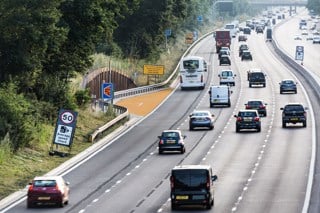The Government has announced a series of measures to improve the safety of Smart Motorways, following a review commissioned by Transport Secretary Grant Shapps.
Today’s announcement secures the future of the roads, with an 18-point improvement plan (detailed below).
Analysis commissioned by the Transport Secretary reportedly found that "in most ways", smart motorways are as safe as, or safer than, conventional ones.
The report highlights risks that are lower on smart motorways compared with conventional motorways; include tailgating, rapid changes of vehicle speeds, vehicles drifting off the carriageway and vehicles being driven too fast.
There was also an admission that some risks are higher than on conventional motorways, for example the risk of a collision between a moving and stationary vehicle.
In order to address these risks, the Transport Secretary’s new measures include abolishing confusing “dynamic hard shoulder” motorways and substantially speeding up the deployment of “stopped vehicle detection” – a radar-based system which spots stationary vehicles – so that it is installed across the entire smart motorway network within 36 months.
This will enable broken down drivers to typically be detected within 20 seconds, with lanes closed more quickly.
Shapps said: “I’ve been greatly concerned by a number of deaths on smart motorways, and moved by the accounts of families who’ve lost loved ones in these tragic incidents.
“I commissioned an urgent stocktake of smart motorways to provide a clearer picture of their safety and make recommendations on next steps. I envisaged it to be swift, but during the course of our investigations a complex picture emerged – which warranted further work.
“That work has now concluded and overall, evidence shows that in most ways smart motorways are as safe as or safer than conventional ones.
“But I am clear that there is more we can do to raise the bar on smart motorway safety. The extended package of measures I have set out will help rebuild public confidence in our motorway network and ensure that safety is firmly at the heart of the programme.”
The AA has commended the review, having spent a decade campaigning for improvements to the design and safety of Smart Motorways.
Edmund King, AA president, said: “The fact that 38% of breakdowns happen in live lanes on smart motorways means drivers have been at risk. Tragically people have lost their lives, and in some cases coroners have indicated this could have been avoided.
“No driver wants to be stuck in a live lane with nowhere to go; at best it is incredibly distressing, at worst it can be fatal.”
Anthony Smith, chief executive of the independent watchdog Transport Focus, added:
“We know road users are concerned about safety when they think what would happen if they broke down on a motorway with no hard shoulder. So we welcome this package of improvements including more technology to detect breakdowns quickly and for there to be extra effort to spread the word about what to do if you break down.
“We will be pressing Highways England further in two areas. First, to confirm that the M4 smart motorway, between Reading and Heathrow, will have additional safety features from day one. Second, to check that red ‘X’ gantries on all smart motorways are spaced appropriately so they can protect people if something goes wrong.”
The 18 points outlined in Shapp’s plan are:
- Abolishing the confusing “dynamic hard shoulder” smart motorways, where the hard shoulder operates only part-time and is a live running lane the rest of the time
- Substantially speeding up the deployment of “stopped vehicle detection” technology across the entire “all lane running” smart motorway network, so stopped vehicles can be detected and the lanes closed more quickly. Highways England is to accelerate its plans and install the technology within the next 36 months, setting a clear public timetable for the first time
- Faster attendance by more Highways England traffic officer patrols on smart motorways where the existing spacing between places to stop in an emergency is more than one mile, with the aim of reducing the attendance time from an average of 17 minutes to 10 minutes
- Reducing the distance between places to stop in an emergency to three quarters of a mile where feasible so that on future schemes motorists should typically reach one every 45 seconds at 60mph. The maximum spacing will be 1 mile
- Installing 10 additional emergency areas on the existing M25 smart motorways on the section of smart motorway with a higher rate of live lane stops and where places to stop in an emergency are furthest apart
- Considering a national programme to install more emergency areas where places to stop in an emergency are more than one mile apart
- Investigating M6 Bromford viaduct and the M1 at Luton, Sheffield and Wakefield where there is evidence of clusters of incidents. Where an intervention is considered likely to make a difference, we will look to make changes at these locations
- Making emergency areas more visible – all emergency areas will have a bright orange road surface, dotted lines on the surfacing showing where to stop, better and more frequent signs on approach and signs inside giving information on what to do in an emergency. These will be installed by the end of spring 2020
- More traffic signs giving the distance to the next place to stop in an emergency, so you will almost always be able to see a sign. Typically, these will be between approximately 330 and 440 yards apart
- More communication with drivers. We recognise that we could do more therefore we are committing to an additional £5m on national targeted communications campaigns to further increase awareness and understanding of smart motorways, how they work and how to use them confidently
- Displaying ‘report of obstruction’ messages automatically on electronic signs, triggered by the stopped vehicle detection system, to warn drivers of a stopped vehicle ahead, this is currently being trialled on the M25 and then a further trial on the M3
- Places to stop in an emergency shown on your satnav by working with satnav providers to ensure the locations are shown on the screen, when needed
- Making it easier to call for help if broken down by working with car manufacturers to improve awareness of the use of the eCall ‘SOS’ button in newer cars to call for help
- We have changed the law to enable automatic detection of ‘red X’ violations and enforcement using cameras and we will be expanding the upgrade of smart motorway cameras (HADECS) to identify more of those who currently ignore the ‘red X’. The penalty is 3 points on the driver’s licence and a £100 fine, or the driver can be referred to an awareness course
- An update of the Highway Code to provide more guidance
- Closer working with the recovery industry on training and procedures
- Reviewing existing emergency areas where the width is less than the current 15 foot wide standard. If feasible and appropriate we will widen to this standard
- A review of the use of red flashing lights to commence immediately. We have listened to the calls for recovery vehicles to be allowed to use red flashing lights. We will commence work immediately on a review.





















Login to comment
Comments
No comments have been made yet.